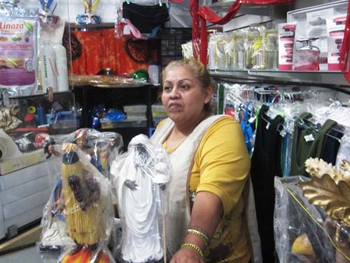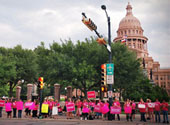Listen to an audio story from Annenberg Radio News:
 Sonia Gastelum in her Botanica Orula #2 (Photo by Kira Brekke) Sonia Gastelum in her Botanica Orula #2 (Photo by Kira Brekke) |
Sonia Gastelum’s Botanica Orula #2 is a small yet amply decorated store located in the depths of South Central on Main Street. The compact store is dedicated to the religion Santeria.
“It’s from Africa and Cuba, it’s Afro-Cuban,” Gastelum said. “We believe in Saints and we believe in spirits.”
Santeria, or “Way of the Saints” in Spanish, is dedicated to devotees building powerful relationships with mortal spirits called Orishas. Gastelum began practicing 35 years ago and has since become a high priest.
“We do a lot of ceremonies here too, spiritual, spiritual cleaning,” Gastelum said.
Gastelum opened her first Botanica in the Lynwood neighborhood of Los Angeles ten years ago. This shop in South Central was opened just last year.
“When [customers] come in here, they ask me what is this store about? Because, they’re not familiar with the store and I tell them, this has to do with things of the religion and everything. They start asking me, ‘What do you see in me? What do you think,” Gastelum said.
There is nothing fortune-telling about Santeria; but Sonia says many customers come in seeking guidance.
Some studies report that nearly a million people practice Santeria in the United States alone; but, an accurate number is hard to know for sure due to the stigmas of practicing. One reason being that animal sacrifices are central to the religion.
“We sacrifice but we don’t make them suffer,” Gastelum said. “A lot of people these days, they’re not explaining it and they’re not understanding it. They hear the word “Santeria” and they think it’s devilish or something, but it isn’t.
UCLA Law Professor Eugene Volokh says that state constitutions provide different levels of protection to religious practices. Volokh says that California is one of the states that provides more protection.
“The questions that would have to be raised is exactly what she is doing, exactly what the relevant laws are,” Volokh said. “There are laws in California regulating the killing of animals. Some are aimed at preventing to unnecessarily cruel deaths for the animals. Some are aimed at protecting hygiene. But, it may very well be that what she is doing is perfectly consistent with those laws.
 Without thinking about legality of Santeria, Gastelum’s store decorations are quite impressive. The walls are filled with a grand array of colorful aromatic candles. She also carries hundreds of other religious paraphernalia, including: statues, crosses, soaps, oils, clothing, and more.
Without thinking about legality of Santeria, Gastelum’s store decorations are quite impressive. The walls are filled with a grand array of colorful aromatic candles. She also carries hundreds of other religious paraphernalia, including: statues, crosses, soaps, oils, clothing, and more.
“Well the inspiration that I get because everything you see here, like the skirts, I make them, and we use them in our religion,” Gastelum said.
The store’s surrounding community is known to be drug and gang ridden. So much so that Gastelum’s first week open began with a shooting outside her front window. Since then Gastelum says her days are safe and she has made a point of encouraging others to accept faith.
“In my house, we think we’re not here to do bad to nobody,” Gastelum said. “You know, we’re here to help out a person; not to harm them in any kind of way.”
The religion has been passed down from generation to generation with the help from story telling and what Gastelum calls her godchildren.
“I have about 500 godchildren,” Gastelum said. “Because every time you’re initiated, you have a godmother, and that godmother is supposed to guide you in the religion and show you things and how it’s supposed to go, you know. If I have that gift that I was initiated, I should use it for good, not for bad.”
As Gastelum sits behind her counter each and every day making much of the store’s merchandise, nearly 20 customers walk in daily hoping to be better themselves and reach the spirits above. While some may frown upon Santeria, Sonia Gastelum seems quite happy.









 On the corner of 38th and Broadway in South Los Angeles sits a small charter high school with a big agenda on its hands. After six years in the same building, the warehouse-turned campus plans to move to downtown LA in the fall. But as Kira Brekke reports, the school has a lot of problems to tackle because it leaves South LA.
On the corner of 38th and Broadway in South Los Angeles sits a small charter high school with a big agenda on its hands. After six years in the same building, the warehouse-turned campus plans to move to downtown LA in the fall. But as Kira Brekke reports, the school has a lot of problems to tackle because it leaves South LA.  Ten years ago the Neighborhood Council system began to try to make city call more responsive to all parts of the city. Volunteers from all over Los Angeles dedicate their own time to tackling problems in their neighborhoods. They are people like Iona Diggs, who is on Chair of the Voices of 90037. Diggs was recently interviewed by Journalist Melissa Leu.
Ten years ago the Neighborhood Council system began to try to make city call more responsive to all parts of the city. Volunteers from all over Los Angeles dedicate their own time to tackling problems in their neighborhoods. They are people like Iona Diggs, who is on Chair of the Voices of 90037. Diggs was recently interviewed by Journalist Melissa Leu. $21 for a single dose of Ibuprofen. $86 for an Ace Bandage. These are the prices hospitals all over the state are allegedly charging patients. And unionized health care workers and community leaders are not happy. Joanna Powers is a licensed vocational nurse at Western Medical Anaheim.
$21 for a single dose of Ibuprofen. $86 for an Ace Bandage. These are the prices hospitals all over the state are allegedly charging patients. And unionized health care workers and community leaders are not happy. Joanna Powers is a licensed vocational nurse at Western Medical Anaheim. Some might argue that such drastic cuts would affect patient safety and care. Joanna Powers disagrees.
Some might argue that such drastic cuts would affect patient safety and care. Joanna Powers disagrees.




